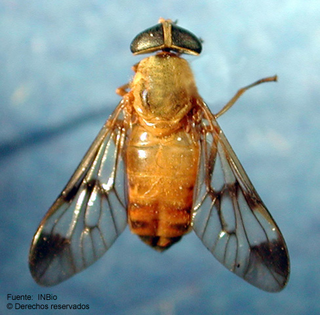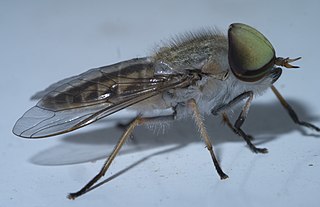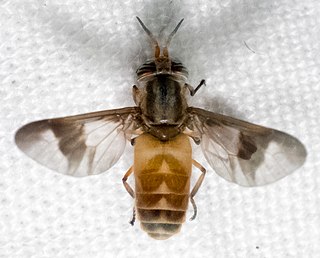Brennania is a genus of flies in family Tabanidae. It was originally known as Comops, created as a subgenus of Apatolestes by Brennan (1935). Philip (1941) then raised it to genus level, but renamed it to Brennania.

Diachlorus ferrugatus, commonly known as the yellow fly in the United States or doctor fly in Belize, is a species of highly aggressive biting horse-fly of the family Tabanidae native to North and Central America to Costa Rica.

Tabaninae is a subfamily in the family Tabanidae commonly known as horse flies. There are more than 3000 described species in Tabaninae.

Chrysopsinae is an insect subfamily in the family Tabanidae commonly known as deer flies or sheep flies and are bloodsucking insects considered pests to humans and cattle. They are large flies with large brightly-coloured compound eyes, and large clear wings with dark bands. They are larger than the common housefly and smaller than the horse-fly.

Tabanus americanus, the American horse fly, is a species of horse-fly in the family Tabanidae.

Silvius gigantulus is a species of horse fly in the family Tabanidae.
Tabanus petiolatus is a species of horse fly in the family Tabanidae. Unlike many Tabanus species, the colour pattern of male eyes is found in the larger, upper lenses - appearing as a dark, brown streak across the light coloured lens. Females of this species have uniformly coloured dark brown eyes. Often confused with Tabanus melanocerus or Tabanus trimaculatus.
Tabanus equalis is a species of horse fly in the family Tabanidae.
Apatolestes hinei is a species of fly in the family Tabanidae.

Apatolestes actites is a species of fly in the horse-fly family Tabanidae.

Tabanus calens is a species of horse fly in the family Tabanidae.
Tabanus dorsifer is a species of horse fly in the family Tabanidae.
Tabanus marginalis is a species of horse fly in the family Tabanidae.
Silvius abdominalis is a species of horse fly in the family Tabanidae.
Chrysops sackeni is a species of deer fly in the family Tabanidae.

Chrysops atlanticus is a species of deer fly in the family Tabanidae.
Goniops chrysocoma is a species of fly found in North America. It is the only species in the genus Goniops, which is in the horse and deer flies family Tabanidae.
Chrysops clavicornis is a species of deer fly in the family Tabanidae.

Tabanus punctifer, commonly known as the western horse fly, is a species of horse fly in the family Tabanidae. This species of horse fly is approximately 20.5 mm long. They are typically found throughout the southern and western parts of the United States. They can be found between Utah and Mexico, and between California and Texas. The thorax is covered with long hairs that give it a creamy white color, while the abdomen is completely black. Much like other horse fly species, the Tabanus punctifer female requires a blood meal for the development of their eggs. Females will bite horses, livestock, and humans, making them vectors of disease for pathogens and parasites.

Pangoniinae is a subfamily of horse-flies in the order Diptera, containing at seven tribes and over 40 genera.











